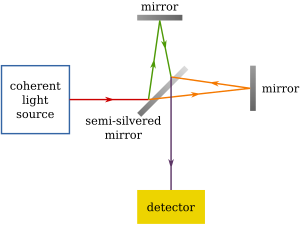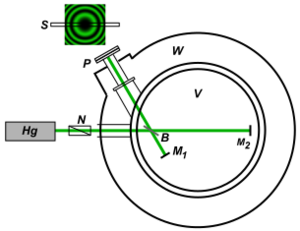Theory of relativity facts for kids
The theory of relativity is a big idea in physics from Albert Einstein. It includes two main parts: special relativity (published in 1905) and general relativity (published in 1915). Special relativity deals with how things move when there's no gravity. General relativity explains how gravity works and how it connects to other forces in nature. It's used to understand huge things like the universe and stars.
This theory completely changed how scientists thought about physics and astronomy in the 20th century. It replaced older ideas from Isaac Newton that had been around for 200 years. Einstein's theory introduced amazing concepts like:
- Spacetime: This is a four-dimensional idea that combines space and time.
- Relativity of simultaneity: This means two events that happen at the same time for one person might not happen at the same time for another person who is moving.
- Time dilation: Time can actually slow down or speed up depending on how fast you're moving or how strong gravity is.
- Length contraction: Objects can appear shorter when they are moving very fast.
Relativity also helped us understand tiny particles and how they interact. It even led to the nuclear age. Thanks to relativity, scientists could predict incredible things in space like neutron stars, black holes, and gravitational waves.
Contents
How the Theory of Relativity Developed
Albert Einstein first shared his theory of special relativity in 1905. He built on ideas and discoveries from other scientists like Albert A. Michelson, Hendrik Lorentz, and Henri Poincaré. Later, scientists like Max Planck and Hermann Minkowski added to this work.
Einstein then worked on general relativity between 1907 and 1915. Many others helped him refine it after 1915. The final version of general relativity was published in 1916.
The name "theory of relativity" came from Max Planck in 1906. He called it "relative theory" because it focused on the principle of relativity. Soon after, Alfred Bucherer used the exact phrase "theory of relativity."
By the 1920s, most scientists understood and accepted special relativity. It quickly became a key tool for studying atomic physics, nuclear physics, and quantum mechanics.
General relativity took longer to be fully accepted. At first, it seemed to only make small changes to Newton's ideas about gravity. It was also hard to test because most of its predictions were about huge things in space. Its mathematics was also very complex. But around 1960, general relativity became super important in physics and astronomy. New math tools made it easier to understand. As scientists discovered new space events like quasars (1963), the microwave background radiation (1965), pulsars (1967), and the first black hole candidates (1981), general relativity helped explain them. These discoveries also proved the theory was correct.
Understanding Special Relativity
Special relativity is all about the structure of spacetime. Einstein introduced it in his 1905 paper, "On the Electrodynamics of Moving Bodies." (Many other physicists and mathematicians also contributed to its history.) Special relativity is based on two main ideas that were quite new compared to classical mechanics:
- The laws of physics are the same for everyone, no matter how they are moving at a steady speed (principle of relativity).
- The speed of light in empty space is always the same for all observers. It doesn't matter how fast the observer or the light source is moving.
This theory explains experiments better than older ideas. For example, the second idea helps explain the Michelson–Morley experiment. Special relativity also has some surprising effects:
- Simultaneity is relative: Two events that happen at the same time for one person might not be simultaneous for another person who is moving.
- Time slows down: Clocks that are moving appear to tick slower than a clock that is standing still.
- Length shrinks: Objects appear shorter in the direction they are moving when they are going very fast.
- Speed limit: Nothing can travel faster than the speed of light in empty space.
- Even the effect of gravity can only travel at the speed of light.
- Mass and energy are connected: This is the famous equation E = mc2. It means energy and mass are basically the same thing and can change into each other.
The key difference in special relativity is that it uses Lorentz transformations instead of the older Galilean transformations to describe how things change when they move.
Understanding General Relativity
General relativity is Einstein's theory of gravity, developed between 1907 and 1915. It started with the equivalence principle. This principle says that being in accelerated motion (like when you're pushed back in a car) feels the same as being in a gravitational field (like standing on Earth).
A big idea from this is that free fall (like an astronaut floating in space) is actually inertial motion. This means an object in free fall is moving naturally without any force pushing it. This was a huge change from classical mechanics, which said gravity was a force pulling things down. To explain this, Einstein suggested that spacetime itself is curved. He worked with mathematician Marcel Grossmann and realized that Riemannian geometry, a type of math from the 1800s, could describe this curved spacetime.
In 1915, Einstein created the Einstein field equations. These equations show how the curvature of spacetime is linked to the mass, energy, and momentum within it.
Here are some cool things that general relativity predicts:
- Gravitational time dilation: Clocks run slower when they are in a stronger gravitational field.
- Orbit changes: Planets' orbits can shift in ways that Newton's theory didn't predict. This has been seen with Mercury and in binary pulsars.
- Light bends: Rays of light bend when they pass near a strong gravitational field.
- Frame-dragging: Huge spinning objects can "drag" the spacetime around them.
- Expanding universe: The universe is getting bigger, and some parts of it are even speeding up their expansion.
Simply put, general relativity is a theory of gravity that uses the Einstein field equations. The solutions to these equations describe the shape of spacetime and how objects move naturally within it.
How Scientists Tested Relativity
Einstein said that the theory of relativity is a "principle-theory." This means its ideas are not just guesses. They are based on what we see in nature. Scientists observe how things work, create math models to describe them, and then figure out what must be true. Experiments then check if these predictions match what actually happens.
Testing Special Relativity

Relativity is a testable theory. It makes predictions that can be checked with experiments. For special relativity, these include the idea that the laws of physics are the same for everyone, that the speed of light is constant, and that time can slow down. Many tests since 1905 have confirmed special relativity. Three key experiments between 1881 and 1938 were very important: the Michelson–Morley experiment, the Kennedy–Thorndike experiment, and the Ives–Stilwell experiment.
Before Einstein, scientists thought light waves needed a medium to travel through, like sound needs air. They called this hypothetical medium the luminiferous aether. The Michelson–Morley experiment was designed to find this "aether wind" as Earth moved through it. In 1881 and 1887, the experiment found no aether wind. This was a surprise, but scientists accepted the result. To try and save the idea of the aether, some scientists suggested that objects might shrink as they moved through it. This was the start of FitzGerald–Lorentz contraction. The Michelson–Morley experiment showed that the time it takes for light to travel back and forth is the same in all directions.
While the Michelson–Morley experiment showed light's speed was the same in all directions, it didn't say if the speed itself changed in different moving frames. The Kennedy–Thorndike experiment, first done in 1932, was designed to check this. It also found a "null result," meaning no change. This led to the conclusion that the round-trip time for light is the same in all steady-moving frames.
The Ives–Stilwell experiment, first done in 1938, tested the transverse Doppler effect. This is the change in light's color from a moving source when viewed from the side. Einstein had predicted this in 1905. The experiment compared observed changes to classical predictions and found a correction factor, just as special relativity predicted. This showed that the frequency of a moving atomic clock changes according to special relativity.
These classic experiments have been repeated many times with even greater accuracy. Other tests include checking how energy and momentum increase at high speeds and more experimental testing of time dilation.
Testing General Relativity
General relativity has also been confirmed many times. The most famous classic tests are:
- The slight shift in Mercury's orbit around the Sun.
- The bending of light by the Sun's gravity.
- The gravitational redshift of light, where light loses energy as it climbs out of a gravitational field.
Other tests have confirmed the equivalence principle and frame dragging.
Modern Uses of Relativity
Relativity isn't just a cool theory; it has important practical uses in engineering today. For example, satellite-based measurements need to consider relativistic effects. Each satellite is moving relative to someone on Earth, so it's in a different "frame of reference."
Global positioning systems like GPS, GLONASS, and Galileo must account for all relativistic effects to work accurately. This includes the effects of Earth's gravity. High-precision timekeeping also relies on relativity. Even instruments like electron microscopes and particle accelerators wouldn't work correctly if scientists ignored relativistic ideas.
See also
 In Spanish: Teoría de la relatividad para niños
In Spanish: Teoría de la relatividad para niños
- Doubly special relativity
- Galilean invariance
- General relativity references
- Special relativity references


